
Recently, the sun scares, many people write that it is dangerous, especially during a period of high activity. In fact, this period is dangerous only in the sense that the sun has more powerful flares that cause magnetic storms. These storms do not affect the amount and quality of ultraviolet radiation. And in this respect, the sun can always be both a friend and an enemy.
It is because of an overabundance of ultraviolet light that fatigue, a feeling of weakness, and sometimes even a temperature increases. If this happens, you need to take a warm shower, drink tea with syrup or a decoction of rosehip, take a multivitamin and lie down in a darkened room. On this day, you do not need to go out in the sun anymore.
Solar threat: how to protect yourself
The spring sun is dangerous for vision – bright rays, not yet shaded by foliage, overload the eyes and can even cause burns to the retina. But it is not necessary to completely isolate vision from the sun: indirect sunlight is useful for both vision and the brain, which receives light energy through the eyes. Therefore, in the morning or after 16 o’clock in the afternoon, you can not be afraid to be outdoors for a while and without sunglasses.

But the greatest risk is those who immediately begin to actively sunbathe, sometimes working for hours in the garden in open clothes or even in a swimsuit. We can predict with confidence that they will burn those parts of the body that fall under direct sunlight.
The most unpleasant thing about a sunburn is that you don’t feel it right away. But even the most severe burns are dangerous not by themselves, but, which cause deep skin changes. Doctors are alarmingly warning that excessive exposure to the sun significantly increases the incidence of skin cancer.
Another danger lies in wait for sun lovers – sunstroke, or heat stroke. This, unfortunately, is possible not only in the hot summer, but also under the spring sun on a windless day, especially if you do not use a hat. It’s just overheating, which can cause dizziness and even loss of consciousness.

First aid in this case is to place the victim in the shade or indoors, loosen tight clothing, bring a cotton wool soaked in ammonia to the nose, and apply cold to the head and heart area (a wet towel, ice wrapped in a napkin).
Who is most exposed to UV light?
Depending on where you are from, as well as on the solar activity, your tan may come very quickly or not at all. In most cases, it depends on the following “types”.
Celtic tanning
Need the strongest UV protection
- Skin – very white or pink
- Eyes – light blue, light gray or light green
- Hair – light or red
- Freckles – a lot
- Tan does not stick to the body
Light-skinned European tanning
Strong UV protection is required
- Skin – light
- Eyes – blue, gray, or green
- Hair – light brown or light
- Few freckles
- Only a slight tan
Black European tanning
UV protection will be needed in the middle of the session
- Skin – yellowish or dark
- Eyes – gray or brown
- Hair – dark brown or brown
- Freckles – rarely
- Tan brown
Mediterranean tanning
You will need UV protection with minimal protection
- The skin is dark
- The eyes are dark brown or black
- The hair is dark brown or black
- There are no freckles
- The tan is very dark
Sunscreen: how to choose and how to use
The rules for choosing sunscreen cosmetics are also simple: the lighter and whiter you are, the more you should have sunscreen factors in the form of milk, cream, or sunscreen oil that you use.

Their choice is great: from “10” – for those who are already slightly tanned and weathered, to “60” – for natural blondes and redheads who have not been in the sun. Especially take care of the children: a child who has been sunburned six times as a child is twice as likely to develop skin cancer later than a child who is protected from sunburn.
How to Apply Sunscreens?
- Apply the protective product to the skin at home, before going out into the air
- Renew the protective layer every 2-3 hours of sun exposure
- Be sure to apply a fresh coat after each bath or swim in the pond
- If you have started a systematic rest after working in the garden, do not forget the main beach rule: sunbathe only in the morning and evening hours, start to sunbathe from 3-5 minutes, gradually bringing them to 20-30 minutes, no more. In this case, the protective agent evenly covers the entire body.




Leave a Reply